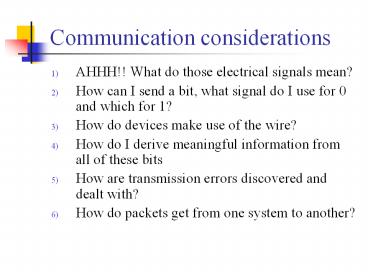Communication considerations - PowerPoint PPT Presentation
Title:
Communication considerations
Description:
Communication considerations. AHHH!! What do those electrical signals mean? How can I send a bit, what signal do I use for 0 and which for 1? ... – PowerPoint PPT presentation
Number of Views:81
Avg rating:3.0/5.0
Title: Communication considerations
1
Communication considerations
- AHHH!! What do those electrical signals mean?
- How can I send a bit, what signal do I use for 0
and which for 1? - How do devices make use of the wire?
- How do I derive meaningful information from all
of these bits - How are transmission errors discovered and dealt
with? - How do packets get from one system to another?
2
Communication Considerations
- How do I send large amounts of data and how do I
ensure that I receive all of my data? - How do machines keep track of who there are
talking to? - What language is this, how can I the computer
understand different formats? - How does a user gain access to the network?
- How do programmers write programs to use the
network?
3
Our solution the OSI model
- Application
- Presentation
- Session
- Transport
- Network
- Data link
- Physical
4
What is a Protocol?
- Allows entities (i.e. application programs) from
different systems to communicate - Shared conventions for communicating information
are called protocols - Includes syntax, semantics, and timing
5
Why Use Protocol Architecture?
- Data communications requires complex procedures
- Sender identifies data path/receiver
- Systems negotiate preparedness
- Applications negotiate preparedness
- Translation of file formats
- For all tasks to occur, high level of cooperation
is required
6
Modular Approach
- Breaks complex tasks into subtasks
- Each module handles specific subset of tasks
- Communication occurs
- between different modules on the same system
- between similar modules on different systems
7
OSI Lower Layers
- Physical
- Data Link
- Network
8
OSI Physical Layer
- Concerned with transmission of unstructured bit
stream over physical medium - Deals with accessing the physical medium
- Mechanical characteristics
- Electrical characteristics
- Functional characteristics
- Procedural characteristics
9
OSI Data Link Layer
- Responsible for error-free, reliable transmission
of data - Flow control, error correction
10
OSI Network Layer
- Responsible for routing of messages through
network - Concerned with type of switching used (circuit v.
packet) - Handles routing between networks, as well as
through packet-switching networks
11
OSI Upper Layers
- Transport
- Session
- Presentation
- Application
12
OSI Transport Layer
- Isolates messages from lower and upper layers
- Breaks down message size
- Monitors quality of communications channel
- Selects most efficient communication service
necessary for a given transmission
13
OSI Session Layer
- Establishes logical connections between systems
- Manages log-ons, password exchange, log-offs
- Terminates connection at end of session
14
OSI Presentation Layer
- Provides format and code conversion services
- Examples
- File conversion from ASCII to EBDIC
- Invoking character sequences to generate bold,
italics, etc on a printer
15
OSI Application Layer
- Provides access to network for end-user
- Users capabilities are determined by what items
are available on this layer
16
OSI in Action Outgoing File Transfer
- Program issues command to Application Layer
- Application passes it to Presentation, which may
reformat, passes to Session - Session requests a connection, passes to
Transport - Transport breaks file into chunks, passes to
Network
- Network selects the datas route, passes to Data
Link - Data Link adds error-checking info, passes to
Physical - Physical transmits data, which includes
information added by each layer
17
OSI in Action Incoming File Transfer
- Physical receives bits, passes to Data Link
- Data Link checks for errors, passes to Network
- Network verifies routing, passes to Transport
- Transport reassembles data, passes to Session
- Session determines if transfer is complete, may
end session, passes to Presentation
- Presentation may reformat, perform conversions,
pass to Application layer - Application presents results to user (e.g.
updates FTP program display)































